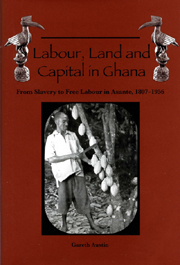Book contents
- Frontmatter
- Contents
- List of Illustrations
- List of Tables
- Preface
- Note on Names
- Maps
- Note on the Maps
- 1 Introduction
- Part I Context and Concepts
- Part II Social Relations of Production and Trade, 1807–1896: Absent and Imperfect Factor Markets
- 5 Land Tenure, 1807–1896
- 6 The Mobilization of Labour, 1807–1896
- 7 Capital and Credit, 1807–1896
- Part III Slavery as Hobson's Choice: An Analysis of the Interaction of Markets and Coercion in Asante's Era of ‘Legitimate Commerce’, 1807–1896
- Part IV The Decline of Coercion in the Factor Markets of Colonial Asante: Cocoa and the Ending of Slavery, Pawnship and Corvée, 1896–c.1950
- Part V Social Relations of Production and Trade, 1908–1956: Towards Integrated Factor Markets?
- Part VI Freedom and Forest Rent, 1908–1956
- Abbreviations Used in the Notes
- Notes
- List of References
- Index
5 - Land Tenure, 1807–1896
from Part II - Social Relations of Production and Trade, 1807–1896: Absent and Imperfect Factor Markets
Published online by Cambridge University Press: 12 September 2012
- Frontmatter
- Contents
- List of Illustrations
- List of Tables
- Preface
- Note on Names
- Maps
- Note on the Maps
- 1 Introduction
- Part I Context and Concepts
- Part II Social Relations of Production and Trade, 1807–1896: Absent and Imperfect Factor Markets
- 5 Land Tenure, 1807–1896
- 6 The Mobilization of Labour, 1807–1896
- 7 Capital and Credit, 1807–1896
- Part III Slavery as Hobson's Choice: An Analysis of the Interaction of Markets and Coercion in Asante's Era of ‘Legitimate Commerce’, 1807–1896
- Part IV The Decline of Coercion in the Factor Markets of Colonial Asante: Cocoa and the Ending of Slavery, Pawnship and Corvée, 1896–c.1950
- Part V Social Relations of Production and Trade, 1908–1956: Towards Integrated Factor Markets?
- Part VI Freedom and Forest Rent, 1908–1956
- Abbreviations Used in the Notes
- Notes
- List of References
- Index
Summary
There is a little-remarked dichotomy in the literature on precolonial or ‘traditional’ land tenure in Asante. The colonial-era ethnography of Rattray and Busia maintained that before colonial rule alienation of land, though legally conceivable, had been rare in the case of mortgage and ‘unknown’ in the case of sale. This would not surprise an economic historian. In market terms the surplus of the potential commodity could be seen as sufficient reason for the lack of exchange, without necessarily following Rattray and Busia in emphasizing religious constraints. The postcolonial historiography, however, has shown that actually a lot of land alienation went on in the eighteenth and nineteenth centuries. But while Rattray greatly understated the frequency and scale of precolonial land alienation, in his later work he identified a crucial distinction within the Asante conception of land tenure which allows us to reconcile the buying or selling of land with the absence of the conditions of scarcity of cultivation rights which would normally be necessary to account for the existence of a market.
This pivotal distinction was between the land itself and its use or occupation. A logical consequence of this was that property in crops, trees and buildings was regarded as separate from property in the land on which they stood. Ownership was legally superior to use-right, in that it was the landowning stool (chieftaincy) which had the right to allocate use-rights.
- Type
- Chapter
- Information
- Labour, Land and Capital in GhanaFrom Slavery to Free Labour in Asante, 1807–1956, pp. 99 - 105Publisher: Boydell & BrewerPrint publication year: 2005

